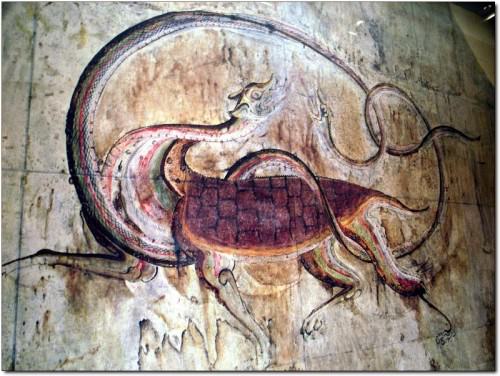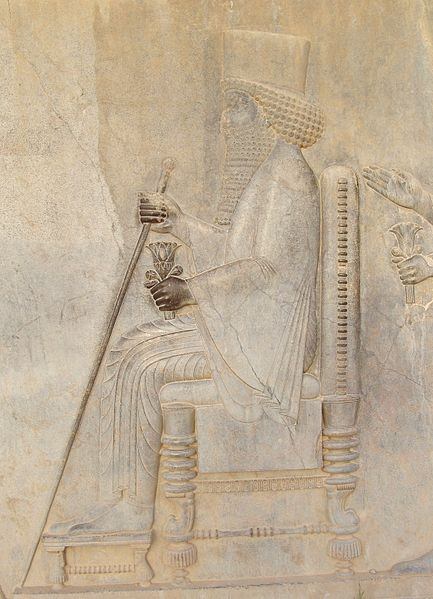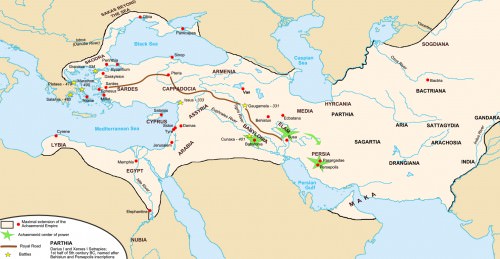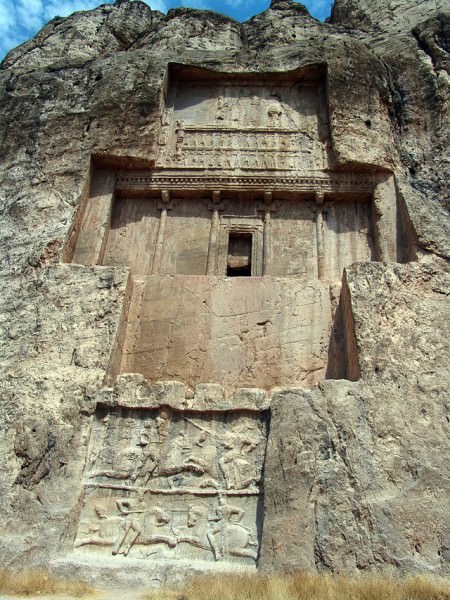Goguryeo › Bureaucracy in the Achaemenid Empire: Learning from the Past » Origins and History
Articles and Definitions › Contents
- Goguryeo › Ancient History
- Bureaucracy in the Achaemenid Empire: Learning from the Past › Antique Origins
Ancient civilizations › Historical places, and their characters
Goguryeo › Ancient History
Definition and Origins

Goguryeo ( Koguryo ) was the kingdom which ruled northern Korea during the Three Kingdoms period from the 1st century BCE to 7th century CE. Goguryeo was in constant rivalry with the smaller Baekje ( Paekche ) and Silla kingdoms, as well as the contemporary Gaya ( Kaya ) confederation and regional heavyweight China. The kingdom flourished in the 5th and 6th century CE and has left a rich cultural heritage best seen in its tomb art and architecture. The kingdom was finally crushed by a combined Tang and Silla army in 668 CE. Thereafter it became a Chinese province, but Goguryeo would not be forgotten as it gave its name to the modern state of Korea.
HISTORICAL OVERVIEW
The traditional founding date of the Goguryeo kingdom was 37 BCE and credited to one Ko Chumong, a refugee from Buyeo (Puyo). In this period five horse-riding warrior tribes formed a loose alliance, the most powerful being the Sono and Kyeru.Their capital was established at Kungnaesong in 3 CE. During the reign of Taejo (53-146 CE) the Chinese commandery at Lintun was taken over in a general campaign of territorial expansion spreading out from the Yalu and Tumen Rivers.
The various tribes of the region began to create a more homogenous political unit structured around five provinces ( pu ) during the reign of Kogukchon (179-196 CE). Kogukchon is also credited with creating a centralised and hierarchical aristocracy, appointing a prime minister, and establishing a system whereby peasants could borrow grain from the state in times of famine and so avoid enslaving themselves to the local aristocratic land owners.
THE REIGN OF GWANGGAETO THE GREAT (391 - 413 CE) WAS KNOWN AS YONGNAK OR 'ETERNAL REJOICING.'
Despite these noble developments, modern historians consider the 4th century CE to be a more certain date for the establishment of a fully centralised kingdom. The same century saw further expansion with the last Chinese commandery at Lelang taken in 313 CE, but disaster struck in 342 CE when Murong Huang invaded from China and sacked Kungnaesong, taking 50,000 inhabitants prisoner. Goguryeo eventually recovered and the Xianbei were subdued in the north in 370 CE. In 371 CE the Baekje king Kunchogo attacked Pyongyang and killed king Gogugwon (aka Kogugwon, r. 331-371 CE). However, by the end of the 4th century CE, Goguryeo had formed an alliance with neighbouring Silla against Baekje, allowing some, if only brief, stability in the region.
The early 5th century CE saw the beginning of Goguryeo's greatest period when, during the reign of Gwanggaeto (391-413), who was appropriately named 'broad expander of domain,' it dominated northern Korea, most of Manchuria, and a portion of Inner Mongolia. So successful was this period that Gwanggaeto even coined a new term for it: Yongnak or 'Eternal Rejoicing'.During the long reign of king Changsu (413-491 CE), Goguryeo continued to prosper and Pyongyang replaced Kungnaesong as the capital in 427 CE. Diplomatic relations were maintained with China (which was weakened and divided at that time into two rival dynasties) while Goguryeo attacked Hansong (modern Gwangju), the Baekje capital, in 475 CE, executing their king Gaero in the process. Goguryeo now controlled 90% of ancient Korea.

Three Kingdoms of Korea
In the 6th century CE, after facing both its rival kingdoms to the south in the previous century, Goguryeo now allied itself with the Baekje kingdom against Silla. All three kingdoms were ambitious for each other's territories, and China was now once more a threat under the Sui dynasty. Goguryeo struck first by attacking the Sui regions to the north. This brought a military response from China, but the general Ulchi Mundok won a great victory for Goguryeo at the battle of the Salsu River in 612 CE. According to legend, of the 300,000-strong Sui army, only 2,700 returned to China. Two more attacks we rebuffed in 613 and 614 CE and Goguryeo built a 480-km (300 miles) long defensive wall in 628 CE so as to deter any further Chinese ambitions.
The new Tang Dynasty did not learn the lesson of their predecessors or worry about the wall, but once again, in 644 CE, the Goguryeo army defeated a combined Chinese land and naval force. The celebrated Gorguryeo general Yang Manchun had crucially managed to hold out at the fortress of Anshi despite a three-month siege. Undeterred by this setback, the Tangs attacked Korea three more times in the next decade, but each time without success.
In 655 CE, in another round of complex regional alliances, Baekje attacked Silla who then called for Tang aid once again, which, when it came, was overwhelming. In 661 CE a Tang army besieged Pyongyang which was weakened by an internal power struggle for the throne. The Tangs were forced to withdraw, but when they attacked again in 667 CE, the city, although this time holding out for a year, finally fell. In 668 CE the Goguryeo king Pojang (r. 642-668 CE) was removed to China along with 200,000 of his subjects in a forced resettlement programme. Both the Baekje and Goguryeo kingdoms were swept aside and became Chinese provinces leaving Silla to dominate the Korean peninsula for the next three centuries.
GOVERNMENT & SOCIAL CLASSES
As with the other two kingdoms of the period Goguryeo was ruled by a monarch with senior administrative positions held by a landed aristocracy. In a structure similar to the Silla sacred bone rank system, individuals belonged to specific social groups based on birth. One's rank dictated which of the 14 levels of administration one could apply for. Below the aristocracy were the taega and soga social ranks and below them the peasantry who worked their own land. At the very bottom of the social ladder were slaves and criminals, who were forced to work on the estates of the aristocracy. The state extracted a tax, usually payable in kind, and could oblige citizens to fight in the army or work on government projects such as building fortifications.

Gilt-bronze Buddha, Goguryeo Kingdom
RELATIONS WITH CHINA
Despite the conflicts between Goguryeo and China over the centuries, the two states were frequent trading partners with the former exporting gold, silver, pearls, and textiles while China sent weapons, silk, and writing materials in return. There were also close cultural ties between the two with Goguryeo adopting the Chinese writing system, wuzhu coins (known locally as oshuchon ), Chinese poetry style, architectural elements (especially regarding tombs), art motifs (again seen in tombs such as constellations painted on ceilings and images of the Chinese animals of the four directions), and belief systems.In 372 CE a National Confucian Academy (the Taehak) was created and Buddhism was adopted as the official state religion(replacing the predominant Shamanism) when it was introduced by the Chinese monk Shundao (Sundo to the Koreans).
GOGURYEO ART
An important art form was wall-painting. Perhaps the most famous surviving examples are found in the 5th-century CE Tomb of the Dancers at Kungnaesog (modern Tonggou). One mural, which gives its name to the tomb, has rows of dancers with arms raised. They wear either long-sleeved robes or jackets and trousers tied at the ankles. Other chambers have paintings of the tomb's occupants, warriors on horseback, a tiger hunt, mythical animals, and details of daily life and architecture. Around 80 Goguryeo tombs contain murals, either painted directly onto the stone chamber walls or applied to a lime plaster. Bright colours and flowing outlines are a typical feature of Goguryeo paintings. It is likely that just as Korean painters learned from their Chinese counterparts, so too, they passed on their knowledge to artists in Japan.

Tortoise & Snake Mural, Goguryeo Tomb
Tombs are also a rich source of artefacts, but the tendency to build easily accessible horizontal entrances has meant that many Goguryeo tombs were looted long ago. Some few surviving art pieces include gilt-bronze crowns and jewellery, which are testimony to the craftsmanship of their creators. Very few examples of Goguryeo pottery have survived and are of dubious provenance. More numerous are bronze and gilt-bronze figurines of the Buddha, which typically show Northern Wei influence with a flaming mandorla and flanked by seated bodhisattvas.
GOGURYEO ARCHITECTURE
There are no extant temples from this period, but some of the more substantial surviving archaeological remains from the Goguryeo towns are walls and fortifications from Tonggou, Fushun, and Pyongyang. Pyongyang, one-time Goguryeo capital, had very large buildings measuring up to 80 x 30 m and palaces with gardens which had artificial hills and lakes. Buildings were decorated with impressed roof tiles carrying lotus flower and demon mask designs, which are found in abundance at the sites.
Better survivors than external buildings are the 10,000 Goguryeo tombs, and the earliest ones took the form of stone cairns using river cobbles. However, by the 4th century CE, square tombs were placed within pyramids made of cut-stone blocks.The largest example is at the former capital Kungnaesong and thought to be that of King Gwanggaeto the Great. 75 metres long and using blocks measuring 3 x 5 metres, it also has four smaller dolmen -like structures at each corner.

Tomb of Gwanggaeto the Great
Another important tomb is that of Tong Shou, last ruler of Taebang. Located near Pyongyang, an inscription dates the tomb to 357 CE. Its central chamber has 18 limestone columns and wall-paintings; it is surrounded by four smaller chambers. More typical, though, of Goguryeo-period tombs than these two examples are more modest hemispherical earth mounds built over a square base and with an interior tomb of stone. Other architectural features seen in various Goguryeo tombs include corbelled roofing, octagonal pillars, and pivoted stone doors.
This article was made possible with generous support from the British Korean Society.
Bureaucracy in the Achaemenid Empire: Learning from the Past › Antique Origins
Ancient Civilizations
In the early days of the Achaemenid empire, the kings came to realise that, if they were to be able to administer the vast mass of land and the multicultural people who inhabited it, they had to create an organizational system that would enable administration without causing any rebellion or disorder and, more importantly, ensure the timely and fair payment of tribute to the court.

Relief of Darius I from Persepolis
One of the major achievements of the Achaemenid rulers was their ability to recognise and utilise the already well-established practices of the conquered lands as well as those systems of government which had come before them; thus the centralised organised mass bureaucracy of the Achaemenid Empire was based on the previously existing Akkadian, Assyrian and possibly Median administration systems as well as the Egyptian.
Under the reign of Cyrus and Cambyses, the conquered areas of Elam, Media, Lydia, Babylonia, Egypt, and several eastern Iranian tribes were more or less in a form of a loose federation of autonomous entities. When it came to tribute, they were subjected to irregular taxation if any at all. The king relied heavily on the non-Persian officials present in the already established form for governments in these “subject states”. These forms for organization, or lack of it, led to clashes between the Iranian noblemen and also to “nationalism” in the conquered areas, which finally resulted in chaos and rebellion after Cambyses' death.
DARIUS ORGANISES HIS EMPIRE
When Darius ascended the Achaemenid throne, he had a major task ahead of him. He not only had to reconquer the rebellious areas but also needed to integrate them into a systematic empire. Knowing that the three main issues that had to be under control for his empire to work were a “sound military, stable economy and a legal system”, he set out to organise the empire with these aspects in mind.

Achaemenid Empire Map
The system of division, which Darius used, can be observed on his tomb in the form of a relief situated on the top part of the rock carving. Here he is portrayed on his throne, which is “supported by 30 figures of equal status”; this symbolized the subject people of the empire. The countries other than Persia or Persis are listed in what seems to be geographical order.

Tomb of Darius I, Naqsh-e Rustem
Herodotus (3.89) mentions that “ Darius joined together in one province the nations that were neighbours, but sometimes he passed over the nearer tribes and gave their places to more remote ones”. Dr. Shahbazi applies this system to the recorded lands in the mentioned relief, and distnguishes between the Persian homeland six other nations. This “seven folded” partition of the empire, which seems to recall the traditional Iranian division of the world into seven regions, illustrates the division of the empire as follows:
- the central region, Persis
- the western region encompassing Media and Elam
- the Iranian plateau encompassing Parthia, Aria, Bactria, Sogdiana, Chorasmia and Drangiana
- the borderlands: Archosia, Sattagydia, Gandara, Sind and Eastern Scythia.
- the western lowlands: Babylonia, Assyria, Arabia and Egypt.
- the northwestern region: encompassing Armenia, Cappadocia, Lydia, Overseas Scythians, Skudra and Petasos-Wearing Greeks.
- the southern coastal regions: Libya, Ethiopia, Maka and Caria.
Within these regions Darius, established 20 provinces, called satrapies (following the model of the Assyrian Empire). Each one had a governor, or satrap, who was directly responsible to the king, and each satrapy had a fixed annual tribute. Herodotus provides us with a detailed list of the satrapies from west to east starting with Ionia, and names their annual tribute paid to the court, as well.
As noted above, the Assyrian administration system seems to have been one of the more important models for the Achaemenid bureaucracy. The Assyrian administration system was reformed extensively by Assyrian king Tiglath-Pileser III (745-727 BCE). Since he had been a provincial governor prior to the coup which made him king, he understood the importance of limiting these administrator's powers. He enacted legislation which divided the satrapies and halved the governor's power so that the provincial governors could not do as he did and rebel against him. By creating officials who were directly under his control, and who supported the local rulers, he was able to hold the local ruler in check. He also started an “intelligence system”, which transmitted reports by using state stage posts, making sure that the “civil servant” remained loyal and efficient.
These Assyrian reforms can be observed in the Achaemenid administration as well. Most of the satraps appointed by Darius were Persian noblemen, who were to administer the tax districts within the satrapies, and each one of these districts could again be subdivided into “sub-satrapies” and again into smaller entities. These had their own governors who had either been appointed by the central court or by the satrap himself.
THE TRUSTED MEN & GOVERNMENT OFFICIALS
To be able to ensure a fair evaluation of each satrapy, the king would send a committee of “trusted men” to assess the income and spending of each district in each satrapy. Babylonian documents from that period show the existence of detailed land registries with property boundaries, ownership and land assessments. Further, the Elamite texts found in Persepolis mention officials who “write people down” and “make enquiries”. In essence, a central peoples' registry was created in each satrapy and was used to assess taxes and probably also to register able-bodied men for the army levies. The policy of "trusted men" who were sent by the ruler to observe and report on activities in the provinces was borrowed from another earlier system: that of the Akkadian Empire (2334-2083 BCE). Sargon of Akkad (2334-2279 BCE), the founder of the empire, instituted this exact system in order to maintain order and prevent rebellion.
The Achaemenid's also borrowed another policy from Akakd. To avoid concentration of power in one person alone, each satrap had a “Royal Secretary”, whose job was to observe the affairs of the state and also to communicate with the king. A “Royal Treasurer” also worked with the satrap, safeguarding the provincial profits. Finally, the “Garrison Commander” was in charge of the military units stationed in the satrapy and was only responsible to the king. Additional inspections were carried out by “Royal Inspectors” who acted as the king's eyes and ears; they had full authority over the satrapy's affairs and answered only to the king.
It seems that the coordination of the imperial administration was the responsibility of the chancery whose headquarters were at Persepolis, Susa, and Babylon. Thus the main cities of the empire, such as Bactria, Ekbatana, Sardis, Dascylium, and Memphis, also must have had their own divisions. It is important to mention that bureaucratic organization was deeply rooted in the Middle East and was also used by Cyrus and Cambyses in the earlier days of the empire; however, Darius reformed it in accordance with the needs of a centralized empire and the subject states.
MONEY & TRADE
Darius also introduced a new monetary system which consisted of silver coins weighing 8 g and gold coins weighing 5.4 g, which corresponded to 20 silver coins. The gold coins were called “Dareiko” or darics. However, it is important to mention that most of the subject nations minted their own coins and used their own monetary systems side by side with the new system introduced by Darius.
CONCLUSION
The early Achaemenid kings, who shaped the Achaemenid Empire and its doctrines, based a number of their practices and administration on earlier bureaucratic systems. Where they really differed from the earlier empires was in their tolerance of, and respect for, the conquered people and their cultural practices and beliefs.
Yes, it was an empire, and “All freeborn inhabitants of the Achaemenid empire were considered subjects of the Persian king.Nevertheless, in some constituent elements of the empire quite different forms of political organization prevailed (eg monarchic, oligarchic, aristocratic, democratic, and theocratic), and the rulers enjoyed autonomy in internal affairs” (Dandamayev, M., 631-632). This was the Achaemenid breakthrough: clearly understanding what was possible and doable with a pre-existing practice or system and understanding what actions were necessary to run the empire efficiently while maintaining the Achaemenid doctrine of tolerance and respect.
LICENSE:
Article based on information obtained from these sources:with permission from the Website Ancient History Encyclopedia
Content is available under License Creative Commons: Attribution-NonCommercial-ShareAlike 3.0 Unported. CC-BY-NC-SA License